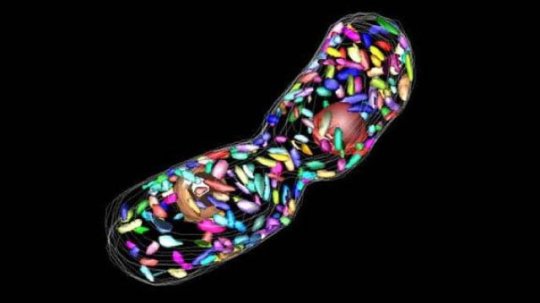
Scientists at Washington University in St.
Louis have discovered a previously unknown strategy photosynthetic
organisms use to protect themselves from the dangers of excessive light,
providing further insight into photosynthesis and opening up new
avenues for engineering this process, which underlies the global food
chain.
The photosynthetic bacterium Chlorobaculum tepidum thrives
in the oxygen-free depths or sediments of lakes. In fact, oxygen can
poison it by damaging its sensitive reaction center, which converts the
energy of light into chemical energy. To survive, the bacterium must
have a finely tuned response to light and oxygen that can be turned up
or down as needed.
This "photosynthetic volume control" allows the bacterium to survive exposure to oxygen, when light could otherwise harm it.
Robert Blankenship, the Lucille P. Markey Distinguished Professor of
Arts and Sciences in Biology and Chemistry, whose research team
discovered this novel mechanism, thinks that the new insight could help
scientists engineer other green organisms to also tolerate oxygen or
provide them with additional ways to dissipate unwanted energy.
The findings are reported in the June 20 issue of the Proceedings of the National Academy of Sciences.
A long-standing mystery
Chlorobaculum is adapted to life in the smelly sulfurous
ooze of lake-bottom muds where there is little or no oxygen. If it is
exposed to oxygen, the bacterium must have a way to shut off
photosynthesis by shunting energy away from its reaction center -- the
heart of photosynthesis where light energy is converted into molecular
energy the cell can use.
The amount of energy hitting the reaction center is controlled by
extensive "antenna complexes." These huge networks of protein and
chlorophyll funnel energy into the reaction center, like the large
arrays of mirrors that concentrate sunlight at a single point in solar
towers.
Plants and other photosynthetic organisms typically rely on extra
pigments, such as orange carotenoids, to safely absorb and disperse
excess energy, thus acting as a sort of molecular sunscreen. This
process is called quenching, and, for more than 20 years, scientists had
known that the antenna protein FMO within Chlorobaculum could quench, but that it did so without carotenoids or other known protections. They had no idea how it did this.
Researchers proposed that rare modifications of amino acids, the
building blocks of proteins, might account for FMO's quenching ability,
but had no way of testing this idea.
"It was really a mystery for a long time," Blankenship said. "We knew
it was a big effect. But there was no way we could figure out how it
actually worked."
A clever solution
The mystery remained unsolved until advances in protein mass
spectrometry allowed Gregory Orf, a postdoctoral scholar then in the
Blankenship lab and now at Arizona State University, to accurately probe
the amino acids deep inside the FMO protein.
There, Orf found not the complex, modified amino acids that
scientists suspected would account for quenching, but simply two normal
cysteines, one of the 20 standard amino acids.
"I noticed that the only amino acids that had any significant
difference in reactivity with and without oxygen were these two
cysteines, and they're the only two cysteines in the whole protein," Orf
said.
The cysteines were next to the two chlorophylls closest to the
reaction center, a good location for a photosynthetic on/off switch.
The researchers found that if they modified these cysteines so that
they were unable to respond to oxygen, or substituted less-active amino
acids for them, the quenching effect disappeared. Each cysteine
contributed its own effect, but they also acted cooperatively, producing
a quenching response greater than the sum of its parts.
"We think that when oxygen is around, cysteine can steal an excited
electron from its nearby chlorophyll to release that light energy in the
form of harmless heat," Orf said.
This cysteine-based quenching mechanism, which is new to the field,
may offer a way to elegantly engineer oxygen tolerance into other
photosynthetic organisms, such as biofuel-producing algae, or into
"artificial" photosynthetic systems.
"That's the importance of this work, I think-other than trying to
understand how this one photosynthetic bacterium works," Blankenship
said.
"This fairly simple mechanism for turning energy transfer on and off could be engineered into several different systems."